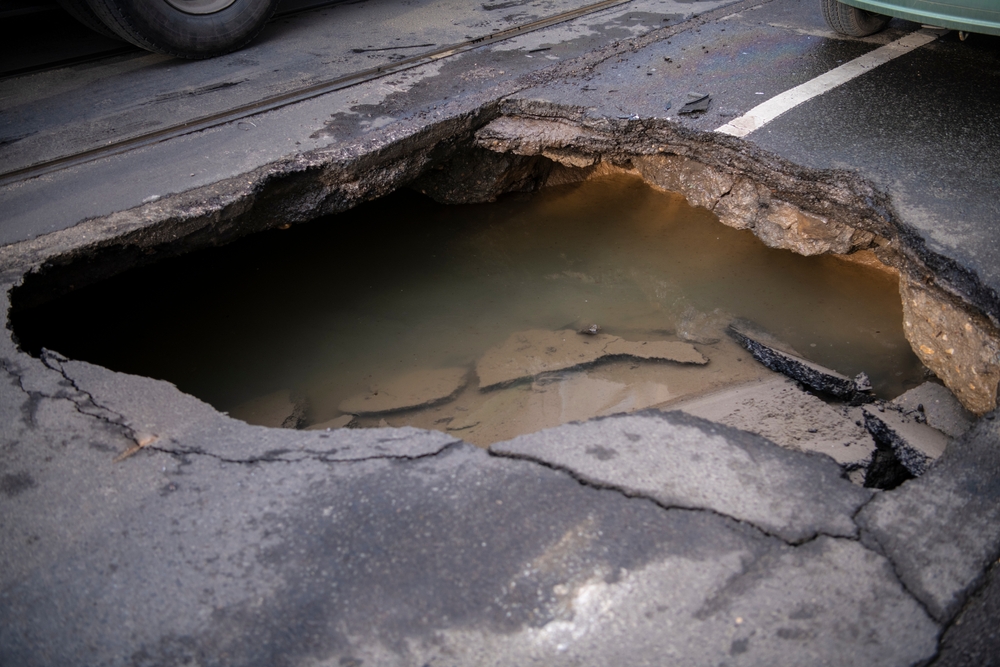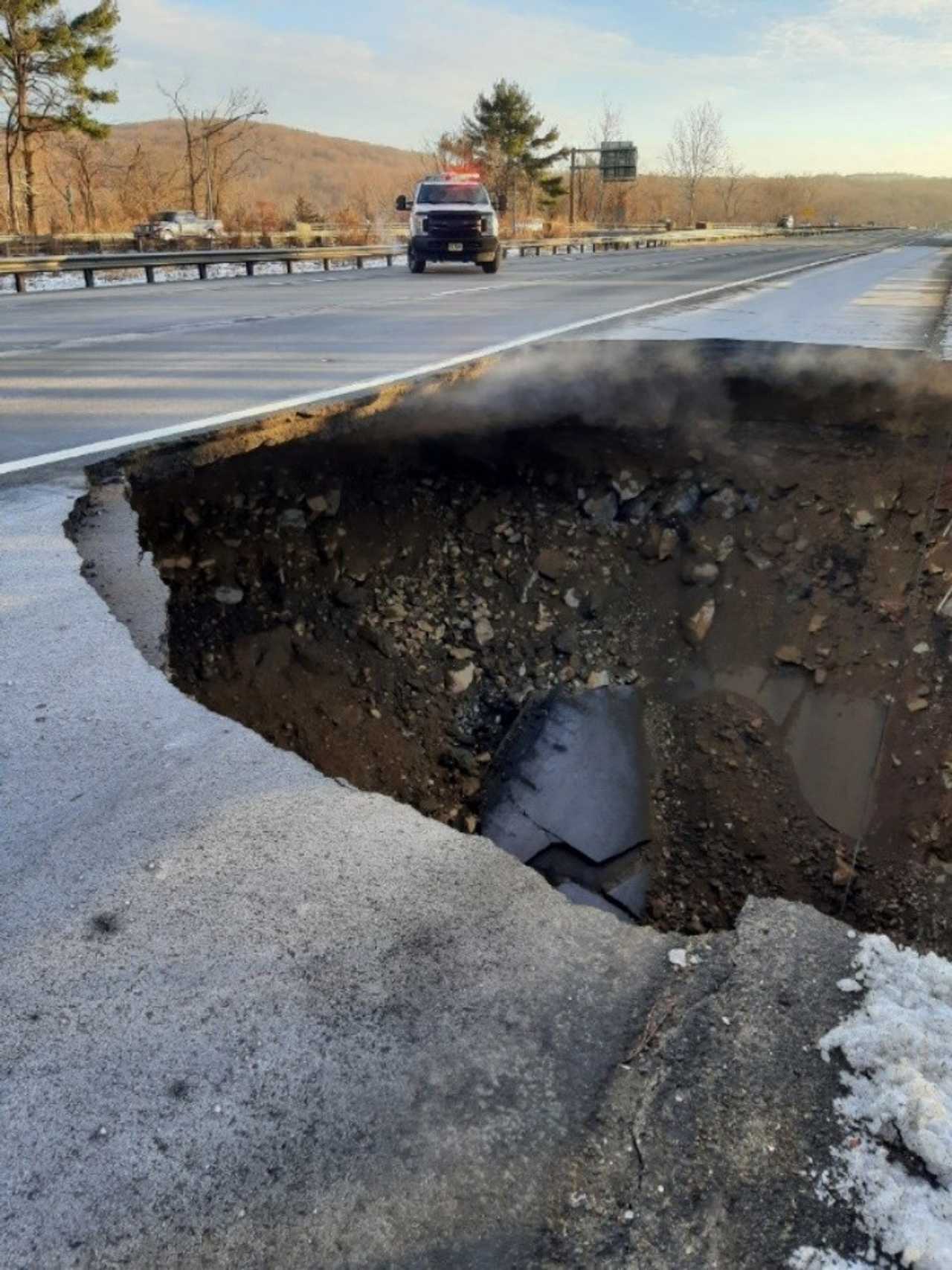Ever heard about Route 80 sinkhole? Well, buckle up because this ain't just some random pothole we're talking about. It's a legit geological phenomenon that has turned heads and sparked debates across communities. Imagine driving down a seemingly normal road, only to find out that the ground beneath you is secretly plotting to swallow your car whole. Sounds like something outta a disaster movie, right? But guess what? This actually happened, and it's got people scratching their heads over what caused it and how to fix it.
Now, you might be wondering why Route 80 sinkhole matters so much. Well, here's the deal: roads are more than just concrete and asphalt. They're lifelines that connect towns, cities, and even states. When a sinkhole strikes, it doesn't just damage the road—it disrupts lives, businesses, and the entire flow of daily activities. So yeah, this ain't just a random crack in the pavement; it's a big deal.
Throughout this article, we're gonna dive deep into the world of sinkholes, focusing on Route 80 and the chaos it brought. From the science behind these ground-swallowing marvels to the solutions being proposed, we'll cover it all. So, let's get started and unravel the mystery of the Route 80 sinkhole!
Read also:Stephanie Soos Husband Face Unveiling The Mystery Behind The Scenes
What Exactly is a Sinkhole Anyway?
Sinkholes, man, they're like nature's way of saying, "Surprise!" Imagine the ground beneath your feet just disappearing without warning. That's basically what happens when a sinkhole forms. But what causes these things? Let's break it down.
Sinkholes occur when the ground beneath the surface starts to erode or collapse. This can happen due to natural processes like water dissolving soluble rocks such as limestone or gypsum, or it can be triggered by human activities like construction or excessive groundwater pumping. And when it comes to Route 80, the sinkhole was a perfect storm of natural and human factors.
Here are some common causes:
- Water erosion
- Underground cavities
- Human activities like mining or construction
- Heavy rainfall or flooding
Why Route 80?
Route 80, my friend, is no ordinary road. Stretching across the heart of America, it's a vital artery for transportation and commerce. But why did it become a hotspot for sinkholes? Turns out, the geology of the area plays a huge role. The region is rich in limestone, which is highly susceptible to erosion. Combine that with heavy rainfall and you've got the perfect recipe for disaster.
The Route 80 Sinkhole Incident: What Happened?
It was a regular day for drivers on Route 80 until BAM! A massive sinkhole appeared, swallowing parts of the road and causing chaos. This wasn't just a small crack; it was a gaping hole that left everyone stunned. Emergency services were called in, traffic was rerouted, and engineers scrambled to figure out what went wrong.
According to reports from the Department of Transportation, the sinkhole measured over 50 feet in diameter and went down several feet into the ground. That's like a small swimming pool just opening up in the middle of the road. Crazy, right?
Read also:Securely Connect Remote Iot P2p Ssh Android A Comprehensive Guide For The Modern Techie
The Impact on Local Communities
For the folks living near Route 80, the sinkhole wasn't just an inconvenience—it was a major disruption. Businesses that relied on the road for deliveries saw their operations grind to a halt. Commuters faced hours of delays as alternative routes were jam-packed with traffic. And let's not forget the psychological impact. Who wants to drive on a road that might just swallow you whole?
How Do Sinkholes Form?
Alright, let's get scientific for a moment. Sinkholes form when the ground beneath the surface starts to weaken and collapse. This can happen due to a variety of factors, but the most common ones are:
- Dissolution: When water seeps into the ground and dissolves soluble rocks like limestone, it creates cavities that eventually collapse.
- Erosion: Over time, water can erode the soil and rocks beneath the surface, leading to sinkholes.
- Human Activity: Activities like mining, construction, and groundwater pumping can destabilize the ground and trigger sinkholes.
Types of Sinkholes
Not all sinkholes are created equal. There are three main types:
- Cover-collapse sinkholes: These are the dramatic ones where the ground suddenly collapses, forming a big hole.
- Cover-subsidence sinkholes: These form gradually as the ground sinks over time.
- Solution sinkholes: These occur when the bedrock is exposed and eroded by water.
The Science Behind Sinkholes
Now, let's dive deeper into the science. Sinkholes are essentially a result of the Earth's natural processes. When water seeps into the ground, it can dissolve certain types of rocks, creating cavities beneath the surface. Over time, these cavities grow larger until the ground above them can no longer support its own weight, leading to a collapse.
Here's a fun fact: sinkholes are more common in certain regions due to their geology. Areas with lots of limestone, like Florida and parts of the Midwest, are particularly prone to sinkholes. And guess what? Route 80 runs right through one of these regions.
Why Limestone Matters
Limestone is a type of rock that's highly susceptible to erosion. When water containing carbon dioxide seeps into the ground, it forms a weak acid that dissolves the limestone. Over time, this process creates cavities and voids beneath the surface, setting the stage for sinkholes.
How to Prevent Sinkholes
Preventing sinkholes is no easy feat, but there are steps that can be taken to reduce the risk. For starters, proper land management is key. This includes monitoring groundwater levels, avoiding excessive pumping, and ensuring that construction projects don't destabilize the ground.
Here are some preventive measures:
- Regular inspections of infrastructure
- Groundwater monitoring
- Proper construction practices
- Education and awareness programs
The Role of Technology
Technology plays a huge role in sinkhole prevention. Advanced tools like ground-penetrating radar and satellite imagery can help detect potential sinkholes before they form. These technologies allow engineers to identify weak spots in the ground and take corrective action before it's too late.
The Future of Route 80
So, what's next for Route 80? Well, the sinkhole has been repaired, but the question remains: is it safe to drive on this road? Engineers and geologists are working hard to ensure that the road is stable and secure. This includes conducting thorough inspections, implementing preventive measures, and monitoring the area for any signs of instability.
But here's the thing: sinkholes are unpredictable. Even with all the technology and expertise in the world, there's no guarantee that another one won't form. That's why it's crucial to stay vigilant and prepared for the unexpected.
What Can Drivers Do?
For drivers, the best course of action is to stay informed. Keep an eye on news reports and road conditions, and be prepared to take alternate routes if necessary. And if you ever see signs of a sinkhole—like cracks in the road or sinking pavement—stay away and report it immediately.
Conclusion: Sinkholes Are No Joke
Route 80 sinkhole is a prime example of how nature can surprise us in the most unexpected ways. From the science behind sinkholes to the impact they have on communities, it's clear that these geological phenomena are no laughing matter. But with proper planning, technology, and vigilance, we can minimize the risks and keep our roads safe.
So, the next time you're cruising down Route 80, take a moment to appreciate the ground beneath your tires. And if you ever feel like the road is shifting beneath you, don't panic—just pull over and call for help. Because when it comes to sinkholes, it's always better to be safe than sorry.
Now, we'd love to hear from you! Have you ever experienced a sinkhole or know someone who has? Share your stories in the comments below and let's keep the conversation going. And don't forget to check out our other articles for more insights into the world of geology and beyond!
Table of Contents
- What Exactly is a Sinkhole Anyway?
- Why Route 80?
- The Route 80 Sinkhole Incident: What Happened?
- The Impact on Local Communities
- How Do Sinkholes Form?
- Types of Sinkholes
- The Science Behind Sinkholes
- Why Limestone Matters
- How to Prevent Sinkholes
- The Role of Technology
- The Future of Route 80
- What Can Drivers Do?


